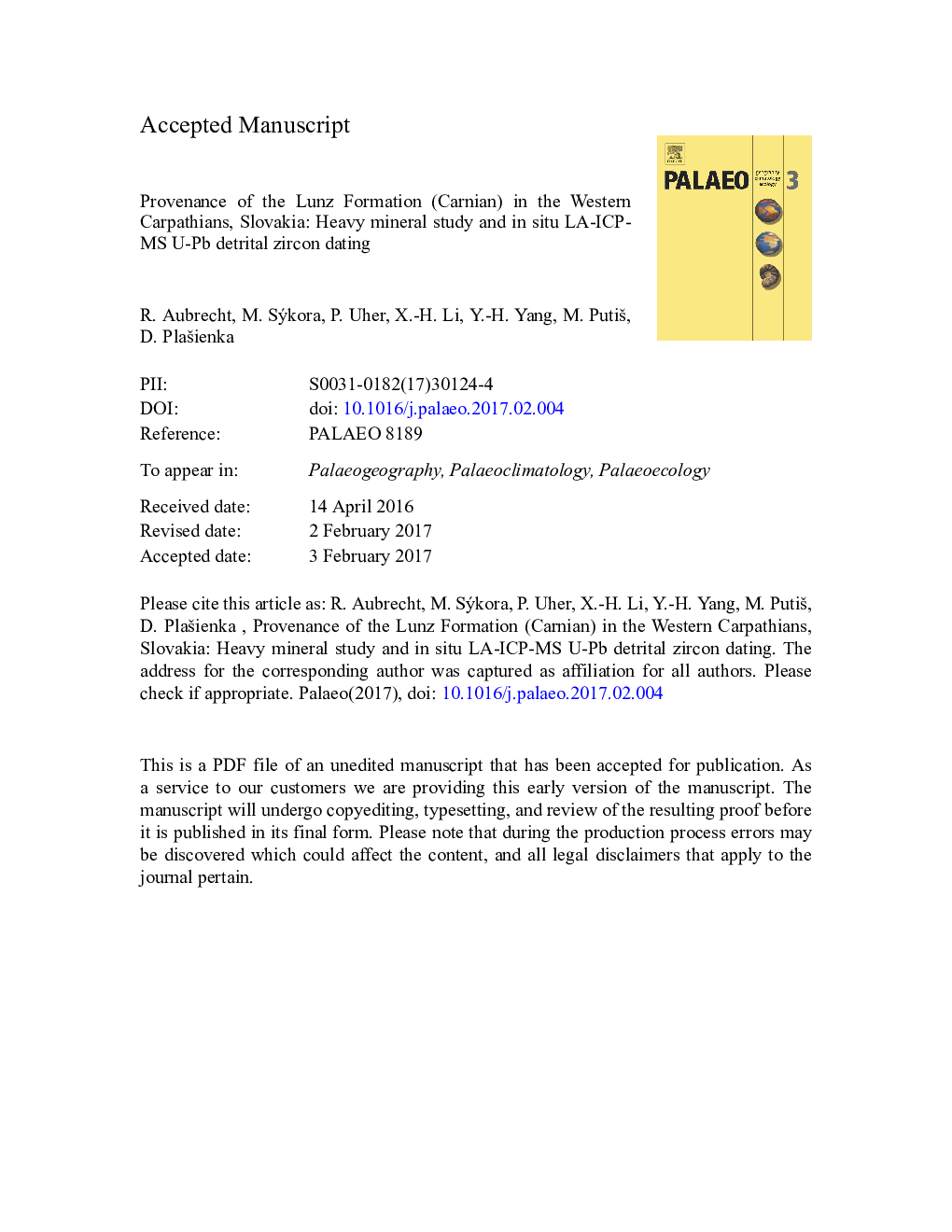| کد مقاله | کد نشریه | سال انتشار | مقاله انگلیسی | نسخه تمام متن |
|---|---|---|---|---|
| 5755940 | 1622121 | 2017 | 65 صفحه PDF | دانلود رایگان |
عنوان انگلیسی مقاله ISI
Provenance of the Lunz Formation (Carnian) in the Western Carpathians, Slovakia: Heavy mineral study and in situ LA-ICP-MS U-Pb detrital zircon dating
دانلود مقاله + سفارش ترجمه
دانلود مقاله ISI انگلیسی
رایگان برای ایرانیان
کلمات کلیدی
موضوعات مرتبط
مهندسی و علوم پایه
علوم زمین و سیارات
فرآیندهای سطح زمین
پیش نمایش صفحه اول مقاله

چکیده انگلیسی
The Middle Carnian (Julian) detritic sediments of the Lunz Formation were deposited during of the so-called Carnian Pluvial Event. They are the only siliciclastic sediments embedded in purely carbonatic formations. The paper brings the first provenance analysis of this formation from the Western Carpathians (Slovakia), where it occurs in the Hronic, Fatric and Veporic zones. Sandstones of the Lunz Formation belong to feldspatic greywackes and less to lithic greywackes. Modal analyses indicate that the sand material was derived from dissected arc and less from a recycled orogen. The heavy mineral assemblage is dominated by zircon and by apatite, slightly lesser amount of garnet, Cr-spinels and tourmaline. Analysis of tourmalines (schorl and dravite) shows their primary provenance mainly from the metapelites and metapsammites coexisting, or not coexisting with an Al-saturating phase; some were also derived from Fe3Â +-rich quartz-tourmaline rocks, calc-silicate rocks and metapelites, and a slightly smaller group of grains was derived from Li-poor granitoid rocks and their associated pegmatites and aplites. Most of the garnet grains belong to almandine, less to spessartine. All of them have a wide spectrum of potential primary source rocks from low- to medium-grade metamorphic rocks and magmatites. The analysed spinel grains (Cr-rich spinel, chromite and magnesiochromite) match mostly the podiform chromitites, harzburgite and cumulate fields or supra-subduction zone peridotites field, whereas Al-depleted spinel best match the arc volcanic field. Some spinels were affected by alteration or metamorphism. The in-situ LA-ICP-MS isotopic U-Pb dating shows a wide age interval of detrital zircon crystals in the Lunz Formation. Concordant zircon data show a wide interval of Late Triassic (Carnian) to Early Proterozoic ages (~Â 230-2500Â Ma). Majority of zircons shows Paleozoic (pre-Variscan and Variscan) ages, whereas Neoproterozoic to Paleoproterozoic age populations are relatively scarce. Age populations and chemical composition of zircon reveal their dominant primary provenance from various suites of magmatic rocks, including Variscan granitic rocks and pre-Variscan metaigneous lithologies. Characteristic is big scatter in zircon ages and the dominance of ultrastable minerals, as zircon, tourmaline, rutile and Cr-spinels, and quite a good correlation between zircons and Cr-spinels. This indicates that most of the heavy minerals were not directly derived from some distinct primary magmatic or metamorphic sources, but as recycled particles from older sediments, or metasediments. In the context with the previously published palaeogeographic reconstructions, the provenance analysis indicates that the source area was most likely situated outside the Alpine-Carpathian shelf. They are most likely related to the coeval, mostly fluvial Stuttgart Formation in the Central European Basin (Germanic Triassic Basin).
ناشر
Database: Elsevier - ScienceDirect (ساینس دایرکت)
Journal: Palaeogeography, Palaeoclimatology, Palaeoecology - Volume 471, 1 April 2017, Pages 233-253
Journal: Palaeogeography, Palaeoclimatology, Palaeoecology - Volume 471, 1 April 2017, Pages 233-253
نویسندگان
R. Aubrecht, M. Sýkora, P. Uher, X.-H. Li, Y.-H. Yang, M. Putiš, D. Plašienka,